 |
1. “This is the house I lived in as a child in the small Russian town of Vitebsk. I lived here with my 8 other siblings, seven sisters and a brother, and my 2 Jewish parents. I was raised Jewish and accepted it as my religion, which I showed in my later art pieces. While living in this house, I discovered my love for the arts which eventually led to my success in them. Even though my parents, especially my father, were a little disappointed I had chosen art as my career, I still pursued it.”
|
Marc Chagall
Thursday, December 17, 2015
Artifact 1
Artifact 2
 |
| 2. “Here is Paris France, or at least a painting I did of it, where I moved to after Vitebsk. I had been apprenticed under several scholars and artists in Russia, but I believed that I had to find my own way to explore art. A form of art called Cubism was very prominent when I moved to Paris. I had created my own art style and I kept with it, eventually modifying cubism and other art forms into it. My style of art was alien to France as a whole at the time. At first I was not recognized by painters, but by poets, who were very interested in my art because of it's uniqueness. I felt terribly homesick in France and therefor eventually moved back to Russia.” |
"Marc Chagall - View of Paris." Marc Chagall. Web. 18 Dec. 2015.
Artifact 3
 |
| 3. “This is my first wife, Bella Rosenfeld Chagall. We met each other when I was still an apprentice to Leon Bakst. I believe the moment we saw each other, we fell in love. We married in 1915 and moved to Petrograd where my first and only daughter, Ida, was born. Bella was the subject of many of my paintings including ‘Bella with White Collar’ and several others. Sadly, in 1944, my Bella died from a viral infection in New York, located in the United States.” |
"Chagall/ Shagal." Chagall/ Shagal. Web. 18 Dec. 2015.
Artifact 4
 |
| 4. “Here is my daughter Ida; without her I may not have survived to live to such an old age. When Hitler gained power and started taking away modern art, and eventually the Jewish people, I did not realize what was going on until it was too late. By the time I saw what was happening around me, we were trapped in a town called Vichy, in France. Our only hope of surviving was asylum to the United States, but we could not afford the trip. Thankfully, Ida worked with a man named Alfred Barr who worked in the New York Museum of Modern Art. Through their work we gained passage out of occupied France. If it was not for them I do not think we would escaped with our lives.” |
"Ida Meyer." Geni_family_tree. Web. 18 Dec. 2015.
Wednesday, December 16, 2015
Artifact 5
 |
| 5. “This is one of my first paintings, 'I and the Village.' I painted this the year after I moved to Paris, during the time I felt most homesick for Russia. In the painting I included lots of scenes from Vitebsk and the area around it. The line from the peasant’s eyes to the cow’s represents the dependence they had on one another, and the sprig the peasant is holding is the result of that partnership. I tried not only to paint the people and the landscapes ,but also to show what they meant to the people in the village. I painted using my own style, and I enjoyed doing so.” |
"MoMA." Marc Chagall. I and the Village. 1911. Web. 17 Dec. 2015.
Artifact 6
 |
| 6. “Here is a painting I created of my second wife, Valentine “Vava” Brodsky. Vava was introduced to me as a common house cleaner through my daughter Ida, one of the many positive things she did for me in my life. In 1952 we married and remained in Provence, France, where we settled into the town of Saint-Paul-de-Vence. Vava was the driving force behind many of my later works, especially the stained glass for many churches and cathedrals. She helped me further get over the death of Bella, and very much helped me begin painting and creating like myself again.” |
"Find A Grave - Millions of Cemetery Records and Online Memorials."Find A Grave - Millions of Cemetery Records and Online Memorials. Web. 17 Dec. 2015.
Artifact 7
 |
| 7. “This man is named Ambroise Vollard. He is an art collector and dealer I met during my travels through Europe. We formed a friendship and he commissioned me to draw and paint multiple scenes from the Old Testament. I painted a lot of Jewish themed paintings such as‘Green violinist’ and ‘Dancing Mirjam', and I also drew a lot of inspiration from the Christian bible. In addition to my many oil canvasses and gouaches, such as ‘White Crucifixion,’ I created many etchings of biblical scenes. Painting for Vollard was a pleasure and I would do it again.” |
"Artnet Magazine." Artnet Magazine. Web. 17 Dec. 2015.
http://www.artnet.com/magazineus/features/darcy/darcy1-10-07_detail.asp?picnum=5
http://www.artnet.com/magazineus/features/darcy/darcy1-10-07_detail.asp?picnum=5
Subscribe to:
Comments (Atom)